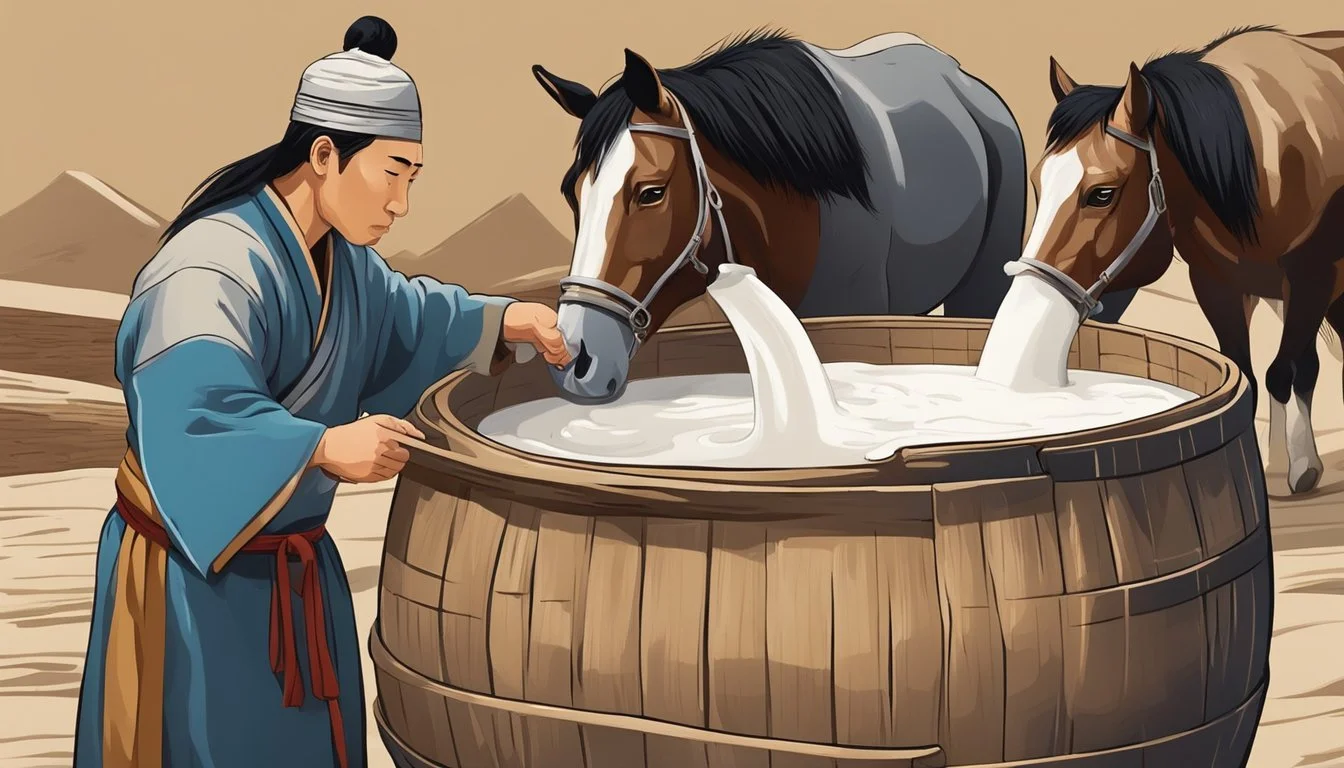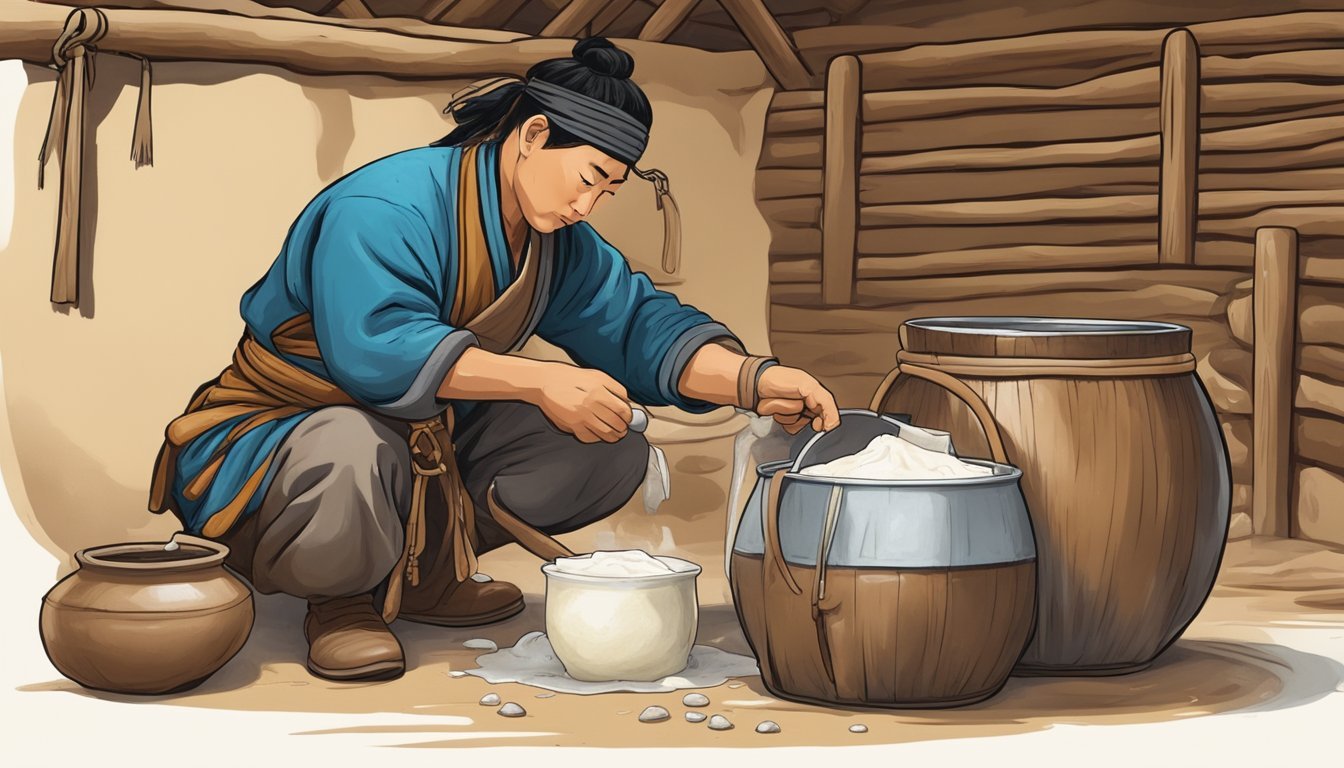Airag The Mongolian Fermented Horse Milk with Unique Health Benefits
Airag, the traditional Mongolian fermented horse milk, is a unique beverage deeply rooted in the cultural heritage of Mongolia. Known for its distinctive tangy taste, this staple drink is produced through a process of fermentation, which involves a combination of lactic acid bacteria and yeast. The significance of the horse in Mongolian history is paramount, not only for transportation and labor but also as a source of sustenance. Mare's milk, the key ingredient of airag, holds a special status in Mongolian society, transcending its role as merely a source of nutrition to become a symbol of life and prosperity.
The preparation of airag is a time-honored practice that reflects the harmonious relationship between the nomadic people of Mongolia and their environment. Freshly milked from mares, the milk is cooled and transferred to a traditional leather sack or wooden barrel, where it undergoes fermentation. Essential to the process is the stirring of the milk with a wooden masher, which is done thousands of times to ensure proper fermentation. Over the course of one to two days, the milk transforms into airag, acquiring its unique flavor and effervescence.
Mongolia's national beverage, airag, is enjoyed by locals and has piqued the interest of curious travelers eager to experience an authentic taste of Mongolian nomadic culture. Its preparation and consumption continue to be a communal activity that reinforces social bonds and celebrates the enduring legacy of Mongolia's pastoral traditions. As a fermented drink, airag also boasts potential health benefits, similar to those attributed to other fermented dairy products around the world.
Historical and Cultural Context
In exploring the rich heritage of Mongolia, one cannot overlook the traditional beverage known as Airag, a symbol of the nation's cultural fabric and the nomadic way of life.
Origins of Airag
Airag is an iconic beverage with its roots deeply entrenched in Mongolian history. Originating from the nomadic herding communities of Mongolia, Airag has been a staple in their diet for centuries. This fermented mare's milk is a testament to the Mongolian people's resourcefulness and their close bond with the land and livestock.
Airag in Mongolian Culture
Mongolians hold Airag in high regard due to its cultural significance. It is more than just a drink; it represents their hospitality and is commonly shared among family and guests. For the nomads of Mongolia, offering Airag is a gesture of welcome and friendship, epitomizing the spirit of Mongolian hospitality. Festivities during the summer months are incomplete without this traditional beverage.
Modern Day Celebrations and Practices
Today, Airag maintains its status at cultural festivals and events, being integral to modern celebrations and daily life in Mongolia. The preparation of Airag is a communal process, often coordinated by women, that echoes the collaborative nature of Mongolian people and nomads. What was once a seasonal routine is now a revered practice that continues to bond communities and uphold Mongolian traditions.
Production Process
The production of Airag intimately relies on the interplay between skilled milking techniques and precise fermentation practices using traditional implements, with the production largely tethered to the seasonal rhythms of spring and autumn.
Milking the Mares
Milking mares is the first critical step in Airag production, with milking occurring up to five times per day during peak seasons. The process is meticulous, as mare’s milk forms the sole ingredient for the fermenting beverage. Herders often selectively breed horses to enhance milk yield and quality, ensuring a consistent and rich supply.
The Role of Fermentation
The essence of Airag's unique flavor and texture lies in its fermentation process. A symbiotic mix of lactic acid bacteria and yeast initiates the fermentation, transforming the lactose in mare's milk into lactic acid, alcohol, and carbon dioxide. This not only imparts Airag with its characteristic tangy zing but also attributes to its preservation.
Traditional Tools and Methods
Traditional Mongolian tools anchor the production process. The Khukhuur, a large container often made from cowhide, serves as the fermentation vessel. Stirring is central to Airag's quality, performed by a Wooden Masher known as buluur, which is immersed and raised through the milk thousands of times to ensure uniform fermentation and prevent curdling.
Seasonal Production Cycles
The cycles of production are governed by the seasons. Primarily in spring and autumn, when mares produce the highest quality milk, Airag production is most favorable. The use of dried yeast—added to initiate the fermenting process—is highly dependent on these seasonal cycles to optimize the growth of the beneficial yeasts and bacteria.
Nutritional and Health Benefits
Airag, the traditional fermented horse milk of Mongolia, offers a range of health benefits due to its unique composition. This section explores Airag's nutritional profile, including its array of vitamins, minerals, and probiotics, and its health impacts on digestion and immune support, as well as its suitability for those with lactose intolerance.
Composition and Nutrients
Airag is a nourishing beverage, noted for its protein content, which is essential for muscle repair and growth. It also contains vitamins such as Vitamin A and Vitamin C, which are vital for maintaining good vision, skin health, and antioxidant properties, respectively. The presence of minerals like calcium and phosphorus in Airag contributes to bone health. Moreover, its fat content, though varying, is typically lower than that of cow's milk.
Vitamin D and Vitamin A contribute to the betterment of the heart and lungs, whereas Vitamin C helps lessen inflammatory responses within the body. Each serving of Airag typically contains:
0.3 to 0.4 milligrams of Vitamin A
95-100 milligrams of Vitamin C
Significant levels of calcium and phosphorus
Digestive and Immune Support
The fermentation process of Airag encourages the growth of probiotics, beneficial bacteria that aid in digestion and bolster the immune system. These probiotics are known to promote gut health and may contribute to improved digestion and absorption of nutrients. Its anti-inflammatory properties, due in part to Vitamin C, can also help calm digestive distress.
Suitability for Lactose Intolerance
Generally, the fermentation process reduces the lactose content present in the milk, making Airag an option for some individuals who are lactose intolerant. However, the degree to which the lactose is broken down can vary, so individuals should approach Airag with caution and based on their own tolerance levels.
Sensory Profile and Consumption
Airag, Mongolia's traditional fermented horse milk, offers a distinct sensory experience characterized by its unique taste and the cultural manner of its consumption.
Taste and Texture
Airag is known for its sour and tangy zing, a flavor profile reminiscent of a cross between yogurt and kefir. The fermentation process results in a slightly alcoholic beverage with a complex taste that also bears hints of sweetness. The texture is often effervescent due to the presence of carbon dioxide, giving it a light fizziness. As for consistency, airag is thinner than yogurt but thicker than milk.
Serving and Presentation
Presentation of airag is integral to the Mongolian nomadic culture. Served in a large open leather sack known as a Khokhuur, it is offered to guests as a sign of hospitality. Traditionally, airag should be stirred with a wooden masher over 500 times to ensure consistency and taste before consumption. The drink is regularly served at room temperature and may accompany various traditional dishes, enhancing the gastronomic experience.
Its alcohol content is typically low but can vary depending on the duration of fermentation. Airag is not only flavorful but also nutritious, making it a central component of the local diet, often compared to probiotic beverages like tarag. The sensory profile of airag, combined with its unique presentation, anchors it deeply in the cultural traditions of Mongolia.
Comparison and Variants
Airag holds a unique place among fermented dairy beverages, known for its distinctive tangy flavor and cultural importance in Mongolia. This section delves into the beverage's international variations and its similarity to other fermented dairy products.
International Varieties
Kumis is the term often used outside Mongolia, particularly in Central Asian countries like Kazakhstan and Kyrgyzstan, where the beverage shares similarities with Mongolian Airag. Traditionally, both Kumis and Airag are made from horse milk, but regional practices can influence the fermentation process and taste. Some variations include the use of cow's milk, although this is less traditional. The fermentation containers also vary, ranging from the traditional Mongolian cowhide sack to wooden barrels or even plastic containers in modern adaptations.
Kazakhstan: Uses primarily horse milk; called Kumis.
Kyrgyzstan: Similar practices to Kazakhstan, with a strong tradition of Kumis consumption.
Similar Fermented Dairy Products
Airag is one in a broader category of fermented dairy products, each with its distinct characteristics and cultural roots. For instance:
Kefir, originating from the Northern Caucasus, is made typically from cow or goat milk with kefir grains and has a creamy consistency and sour taste.
Yogurt is widely consumed around the world and is the result of bacterial fermentation of milk, primarily from cows. It has a thick texture and can range from sweet to tart.
These products differ from Airag not only in the type of milk used but also in the microorganisms responsible for fermentation. Airag's unique fermentation involves a combination of lactic acid bacteria and yeast, giving it a special flavor profile and effervescence that other dairy fermentations do not typically share.
Impact and Sustainability
The production of Airag, Mongolia's traditional fermented horse milk, carries significant environmental and economic implications, directly affecting the nation's nature, nomadic communities, and regional economies during the summer months.
Environmental Considerations
In Mongolia, particularly the regions of Dundgovi, Tuv, Uvurkhangai, Bulgan, and the outskirts of Ulaanbaatar, nomads have adapted their practices to the surrounding environment, ensuring the sustainability of Airag production. The process is largely eco-friendly, as it requires minimal processing and relies on the natural fermentation of mare's milk. In terms of livestock, horses have a lighter ecological footprint than cows or yaks, as they are more adaptable to the harsh Mongolian climate and can graze on less fertile land. This adaptation reduces the strain on local ecosystems and helps maintain the natural balance.
Role in Local Economy
Airag not only holds a valued cultural place but also contributes to the local economy. Nomads engage in the seasonal production of this fermented beverage primarily during the summer months, which supports their livelihood and sustains traditional ways of living. By marketing Airag, especially in regions like Dundgovi and Uvurkhangai, nomadic herders can generate income which, in turn, circulates within the local economy. This product fosters a resilient economic sector that is deeply intertwined with Mongolia's cultural heritage.
Rituals and Traditions
Airag plays a vital role in Mongolian cultural and social events. Traditionally, it is more than just a beverage; it's a symbol of hospitality and respect. When guests arrive, they are often greeted with a bowl of airag, signifying warmth and friendliness. Offering airag to visitors is deeply ingrained in the nomadic customs of Mongolia and represents the host's generosity.
Naadam Festival: During the Naadam festival, which marks one of Mongolia's most significant holidays, airag takes center stage. Competitions in horse racing, archery, and wrestling are accompanied by the communal consumption of airag, celebrating the enduring equestrian culture.
Family Celebrations: Mongolian families use airag in ceremonies and gatherings, from weddings to welcoming a newborn. It binds the community together, reinforcing social ties through shared tradition.
Visitor arrival: Served as a gesture of hospitality.
Naadam Festival: Consumed to honor the equestrian heritage.
Family Events: Integral to rituals, symbolizes unity and celebration.
The preparation of airag itself is a ritualistic process, meticulously executed to ensure the right taste and consistency. Stirring the fermenting mare’s milk hundreds or even thousands of times, as part of its fermentation, is a laborious task that Mongolians undertake with pride and care.
In summary, airag isn't just consumed; it's an integral part of Mongolian social rituals and traditions, reflecting the nation's identity and the significance of the horse in their nomadic lifestyle.
Airag in Mongolian Lifestyle
The traditional beverage Airag holds a place of high esteem in Mongolia, ingrained in daily life and revered for its nutritional properties. It is consumed with gusto by men, women, and children, often serving as a remedy and a refreshment.
Daily Practices and Uses
Airag is a staple in the Mongolian diet and daily ritual, particularly in the summer months when it is favored for its refreshing qualities. Mongolians regard Airag as both a drink to quench thirst and a light nourishment to stave off hunger. Due to its role in social and family gatherings, the making and sharing of this fermented mare's milk is a practice of cultural significance. Transportation of Airag to relatives and as gifts is common, often carried in large open leather sacks named Khokhuur.
Milking: The mares are milked repeatedly.
Cooling: Freshly milked mare's milk is cooled.
Churning: Over 500 times, often thousands, using a wooden masher to stir.
Fermentation Duration: 1-2 days until the milk sours.
This repeated churning not only contributes to the unique taste but serves to mix the milk and ferment it evenly.
Airag's Role in Health and Well-Being
While Airag is primarily consumed for its enjoyment, it also harbors reputed health benefits and some digestive effects. Mongolians traditionally consume Airag to aid digestion, and it is believed to have a mild laxative effect. Some people may experience bloating or gas, which is a common reaction to many fermented dairy products, especially for those unaccustomed to it. Nevertheless, in the landscape of Mongolian traditional medicine, Airag is consumed as a health drink, believed to contribute to the well-being of those who drink it.
The cultural importance of Airag extends to celebrations as well. It is not just an everyday drink but also a beverage that punctuates important events and communal festivities. In such contexts, the preparation and consumption of Airag become a collective activity that reinforces social bonds.
Conservation and Future
As Mongolia navigates the modern world, safeguarding the cultural heritage of Airag is paramount. This distinctive fermented horse milk plays a crucial role in Mongolian traditions and faces the dual challenge of preserving time-honored techniques while embracing innovation.
Preserving Traditional Methods
Cultural Significance: For Mongolians, Airag is not just a beverage; it embodies a living tradition passed down through generations. The intricate process of fermenting mare's milk is deeply interwoven with nomadic lifestyles and is celebrated annually on Tiger Day, the peak of summer when fermentation is ideal due to the climate.
Techniques: Traditional methods include:
Milking mares and cooling the milk.
Transferring the milk to a Khokhuur (large open leather sack).
Stirring with a wooden masher, sometimes more than 500 times.
Allowing the milk to ferment for one or two days.
Mongolians recognize the importance of these practices, as indicated by the registration of the airag-making technique as a UNESCO heritage process. Continuing to honor these methods ensures the survival of this essential aspect of Mongolia's heritage.
Innovation and Adaptation
Fermentation Properties: Research into the properties of mare's milk and its fermented counterpart has opened doors for both scientific understanding and practical adaptation. The knowledge of Airag's probiotic qualities has spurred interest in optimizing fermentation processes and potentially developing new products that respect the original essence of Airag.
Modernization: While tradition forms the bedrock of Airag production, innovators within the community explore:
Enhancement of fermentative bacteria to improve health benefits.
Adoption of food safety standards to meet modern regulations.
Use of contemporary materials that maintain the integrity of the flavor.
Mongolian producers must balance the need to preserve their cherished traditions with the necessity to adapt to a changing world. Such a balance will ensure the perpetuity of Airag, allowing future generations to experience the unique tangy zing of this storied beverage.






